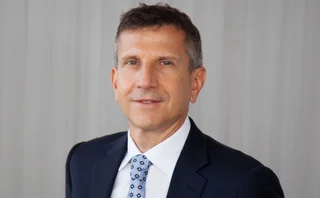
Audio: Abbey Capital investor relations team
Winner: Best investor relations team

Being a fund of commodity trading advisers (CTAs) means Abbey Capital's investor relations team has its work cut out providing education to investors on how these comparatively little-understood strategies work.
While most hedge fund investors are fairly comfortable with equity strategies, CTAs are generally perceived as more complex and unfamiliar. The nature of CTA/managed futures funds, especially the trend-following ones that make up the bulk of the CTA universe, at first glance appears counterintuitive to the average investor. The funds tend to lose money when markets change direction or are directionless but make money when there is volatility. This is one of the reasons the strategy is quickly becoming a favourite with investors who want to diversify risk and hedge their portfolios.
CTAs have had a difficult time over the last couple of years and particularly in 2012. "The nature of managed futures is it tends to be quite a cyclical return. We're in a drawdown at the moment," says Mick Swift, deputy CEO and research director at Abbey Capital.
The company, founded in 2000, focuses on managed futures and foreign exchange investments and offers daily liquidity and full transparency through a segregated managed account structure. The client base includes pension funds, major private banks, multi-family offices, foundations and charities.
A large part of Swift's job is making sure investors have information and explaining what is going on with the strategy. Part of his role is to oversee investor relations together with Andrew O'Donohoe who heads the team based at Abbey's headquarters in Dublin.
"We also position our fund and our strategy to be a relatively longer-term investment strategy," say Swift. "We fundamentally believe that through education, people will better understand the strategy and stay with it in difficult times."
This concept is communicated to prospective investors from the start.
Each client is allocated a client services manager during the initial investment process and that manager stays with the investor once the first allocation is made. They are the investor's first point of contact, communicating company announcements, fund updates and acting as a link between the investor and the rest of Abbey. In addition each investor has a ‘national' account manager who has broader oversight of client services for that investor.
Educating investors about the strategy and Abbey takes a couple of different forms. Initially, the team spends a lot of time with prospective investors before they make the first allocation. This is to help them become familiar with the programmes and answer questions.
Once the client is invested, the team provides updates depending on preferences on a daily, weekly or monthly basis. Abbey also produces papers on various topics such as managed futures or inflation that it sends to investors.
The investor relations team has grown as Abbey Capital has gathered assets. Initially started with $30 million, assets under management have steadily increased, reaching $4.1 billion in August 2012.
Client services have always been a focus of Abbey and since 2011 the team has doubled in size, split between Dublin and New York. O'Donohoe joined in April 2011 to head the team.
Investor relations are seen as central to the overall business. The team has close links with other internal groups and business areas within Abbey. For example, the risk and research team produces a lot of the information disseminated to investors by investor relations. The legal compliance team keeps the team updated on regulatory changes that either need communicating to clients or about which clients may have questions or concerns.
Keeping the investor relations team informed is vital as it needs to keep up to date so it can pass the relevant information to investors. Having contact with different parts of the business aids that process. "To that end our own internal education of our staff and the investor relations team is a key part too," says Swift. "We have regular briefing sessions here for the teams and a lot of cross-team communication on an ongoing basis."
The investment and portfolio managers also have close contact with the investor relations team to explain investment decisions and their outcomes. Again this is often information that needs to be disseminated to investors.
Investor needs differ. Some will want daily reports, others are happy to be updated monthly. Most questions relate to performance but the level of detail required and needed by investors varies.
"One investor may ask what was the performance or what were the drivers of performance over a given month," says O'Donohoe. "Another might ask the same question but want to see it on a weekly or even daily basis. It's the same question, just more granularity."
As Abbey's clients are mainly institutional, Swift says most conversations with investors are highly informed. However, since 2008 the level of information and transparency required by investors has increased across the board.
For Abbey, with underlying managers trading over 260 markets, this is a challenge not only on the transparency and information front but also on risk management. This does give Abbey a lot of information to work with and communicate to investors. For example, quite a lot of stories about and possible drivers for markets give Abbey the ability to inform investors in a concrete way and also help them understand global markets in a wider context, according to Swift.
Post-2008 investors are also more sensitive to market moves and events that impact trades. Whenever there is bad news that could and usually does affect markets or investments, clients will have questions. This is when the investor relations team comes into its own, Swift says.
 Speed of communication is vital to calm investors and avoid redemptions or misunderstandings. A recent example of this was when news broke about MF Global's bankruptcy. "We didn't have exposure but it was very important that we got that message out," says O'Donohoe.
Speed of communication is vital to calm investors and avoid redemptions or misunderstandings. A recent example of this was when news broke about MF Global's bankruptcy. "We didn't have exposure but it was very important that we got that message out," says O'Donohoe.
[Pictured, Andrew O'Donohoe, Abbey Capital]
"Whether it's good or bad news the aim is to get it out to investors as quickly and clearly as possible," he adds. This is usually done via email or telephone, the most common communication methods, regardless of the information being given. Abbey also conducts face-to-face meetings and video conferences as required.
If there is bad news about performance, that should not come as a surprise to investors. "[Investors are] always aware of how the fund is performing at any given time. It's not a case of receiving a quarterly statement and that's the first time they're seeing performance," says O'Donohoe.
Working with clients is a learning process that informs how the team delivers information. This can also be tailored to specific cultures and geographic locations. For example, the Dublin-based investor relations team deals with Asian clients. Having someone in the group who speaks Japanese and has previously lived there and understands the cultural nuances is a benefit when dealing with clients located there, notes O'Donohoe. In Europe, he says, local language speakers are not as important, particularly as most clients speak English, but understanding the culture in which an investor operates is important.
It also helps that Abbey itself is on the sharp end of investor relations. Being an investor in so many underlying managers means it knows what works and what does not in terms of giving clients information. Using that knowledge and experience helps inform Abbey's own approach to investor relations.
Both O'Donohoe and Swift acknowledge there are challenges ahead for the hedge fund industry and particularly funds of hedge funds. For the investor relations team the biggest challenges are keeping on top of, understanding and responding to the changing needs and requirements of clients in a continually evolving regulatory environment.
Regulations that specifically impact Abbey include the European Union's alternative investment fund managers (AIFM) directive and markets in financial instruments directive (Mifid) as well as the Dodd-Frank Act in the US. This means information given and needed by investors is also changing. "There's ongoing evolution and development of the investor relations process," says O'Donohoe.
To keep abreast of developments, the team works closely with the legal and compliance department as well as attending conferences and liaising with industry bodies to understand the relevance of new rules for the industry and specifically investors.
Moving into 2013 Abbey is confident its ability to keep investors informed with the right information in the appropriate format and frequency will continue to be one of its great assets.
Further reading
ACL Alternative Program: Abbey Capital
Abbey Capital Macro Fund: Abbey Capital
Only users who have a paid subscription or are part of a corporate subscription are able to print or copy content.
To access these options, along with all other subscription benefits, please contact info@risk.net or view our subscription options here: http://subscriptions.risk.net/subscribe
You are currently unable to print this content. Please contact info@risk.net to find out more.
You are currently unable to copy this content. Please contact info@risk.net to find out more.
Copyright Infopro Digital Limited. All rights reserved.
As outlined in our terms and conditions, https://www.infopro-digital.com/terms-and-conditions/subscriptions/ (point 2.4), printing is limited to a single copy.
If you would like to purchase additional rights please email info@risk.net
Copyright Infopro Digital Limited. All rights reserved.
You may share this content using our article tools. As outlined in our terms and conditions, https://www.infopro-digital.com/terms-and-conditions/subscriptions/ (clause 2.4), an Authorised User may only make one copy of the materials for their own personal use. You must also comply with the restrictions in clause 2.5.
If you would like to purchase additional rights please email info@risk.net
More on Awards
Environmental products house of the year: ENGIE
ENGIE is driving change in energy transition, with a strong focus on renewable energy and the liberalisation of power markets in Apac, which presents significant long-term growth opportunities. In recognition of its efforts, ENGIE GEMS has been named…
Natural gas/LNG house of the year: ENGIE
ENGIE continues to expand its services to better serve firms in Apac dealing with the challenges of energy risk management and supply
FRTB management solution of the year: Bloomberg
Amid the diverging timeframes and complex requirements of FRTB, Bloomberg offers a consistent, comprehensive and customisable solution for Apac banks preparing for implementation
Newcomer of the year: Topaz Technology
Jon Fox and former colleagues formed Topaz Technology in 2015. Having seen many different systems and, in some cases, written and built a few themselves, there was always something missing, leading them to build a system that unifies risk reporting and…
Technology vendor of the year: Murex
As a technology vendor, Murex places adaptability front and centre of everything it does, constantly enriching its MX.3 platform to ensure institutions can respond to new market opportunities as soon as they spot them
Currency derivatives house of the year: Deutsche Bank
Asia Risk Awards 2024
Interest rate derivatives house of the year: Standard Chartered Bank
Asia Risk Awards 2024
Derivatives house of the year, Taiwan: CTBC Bank
Asia Risk Awards 2024







